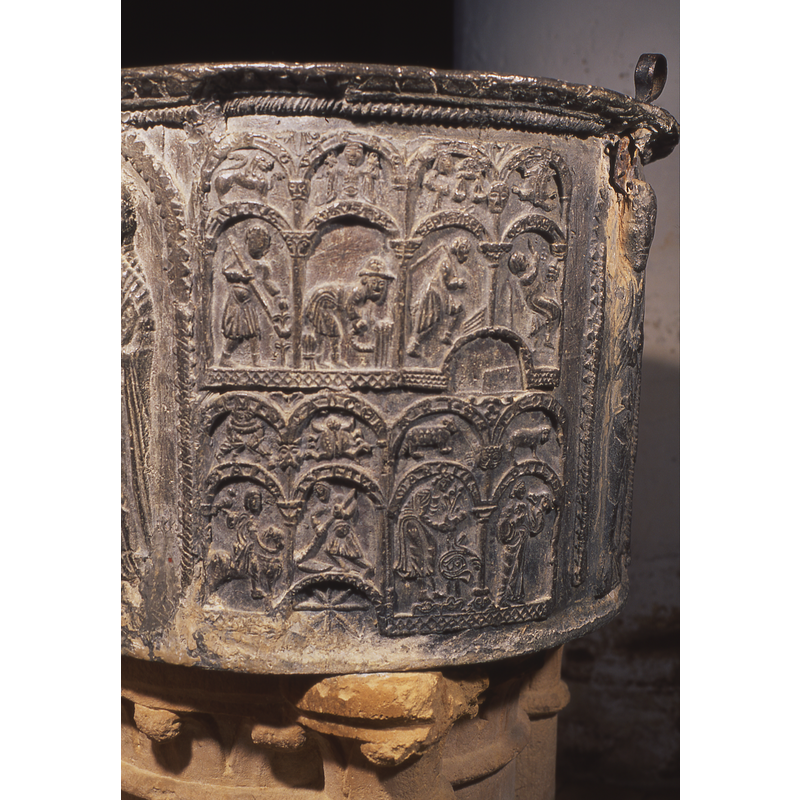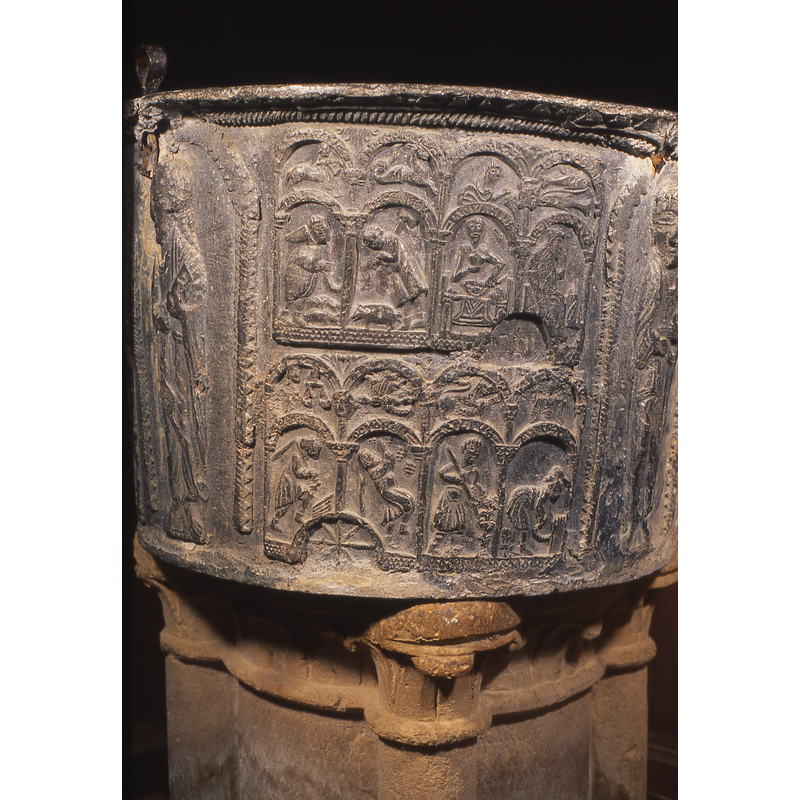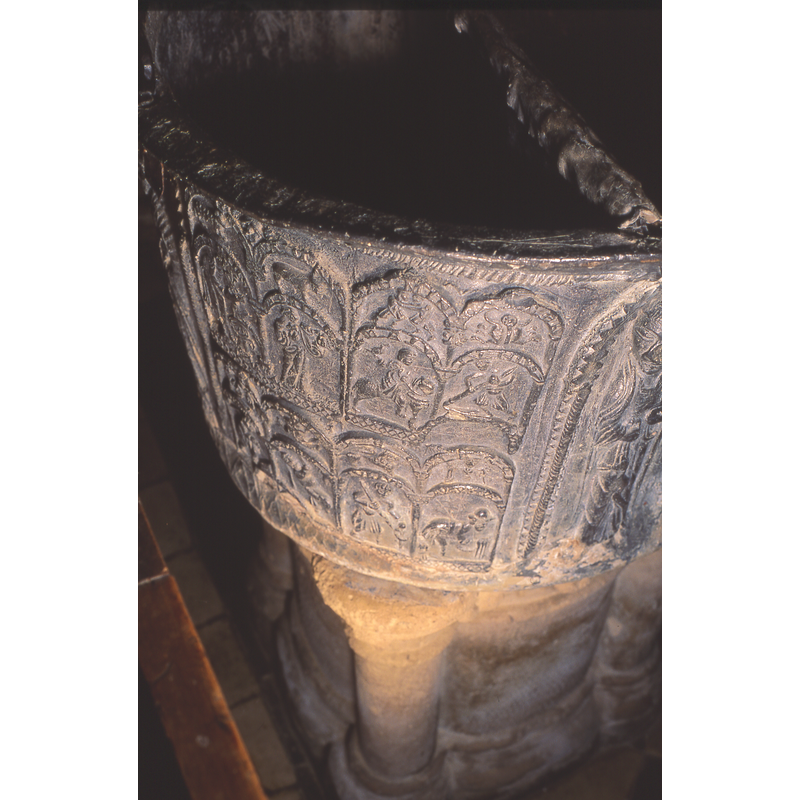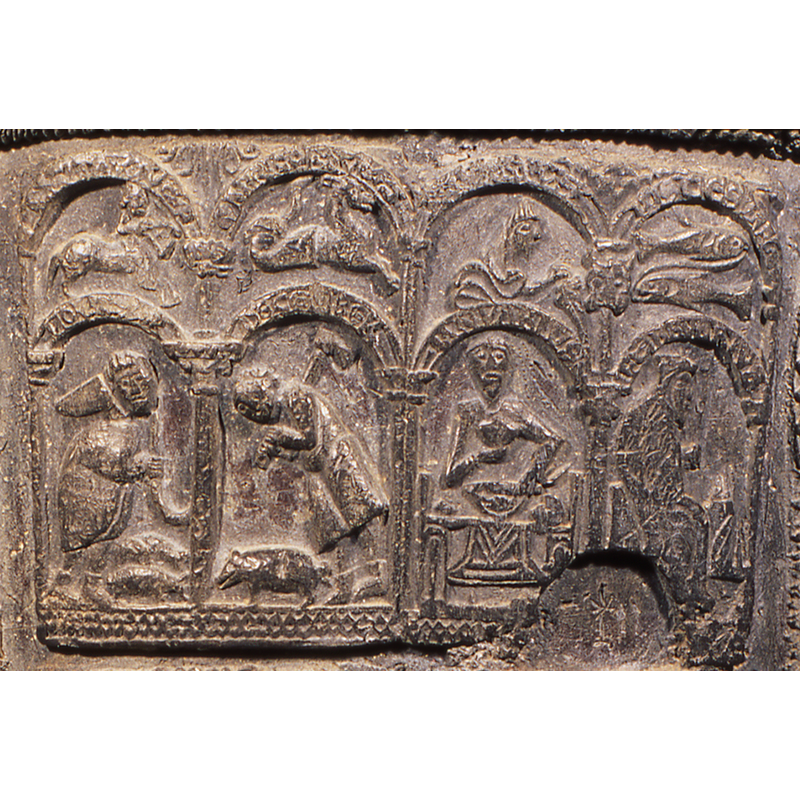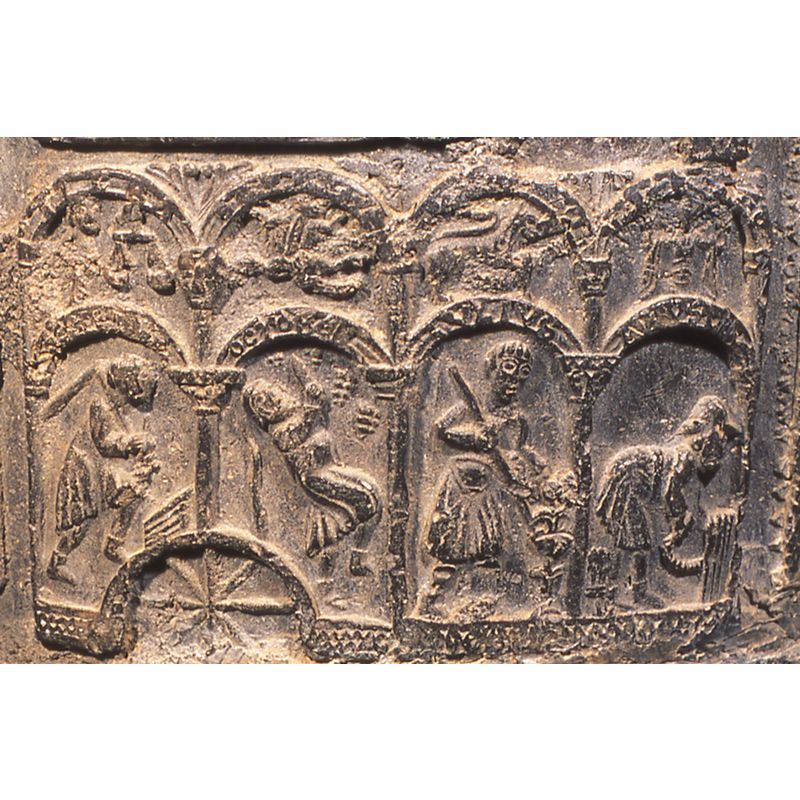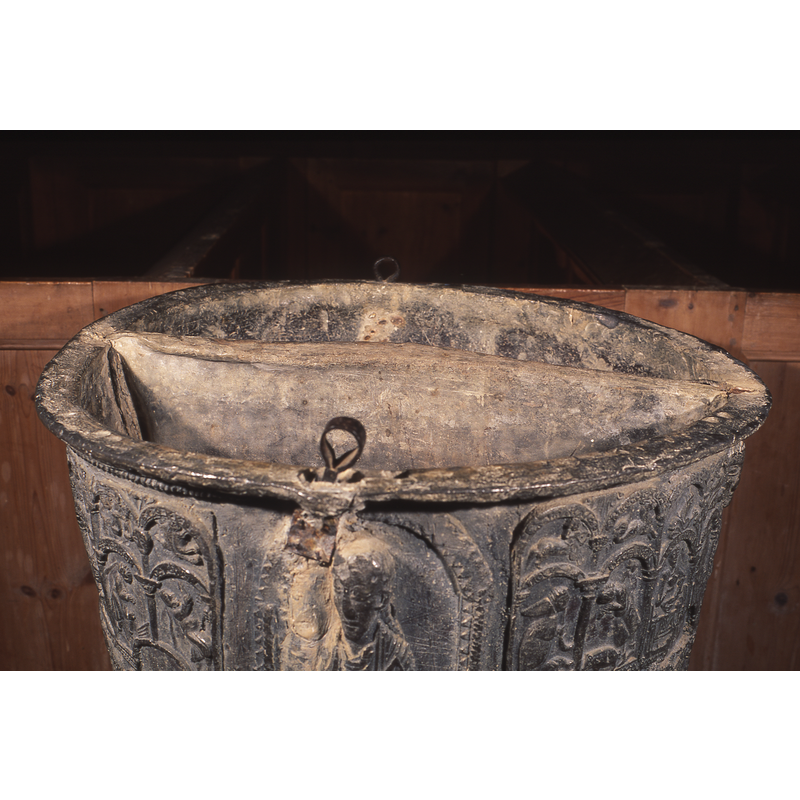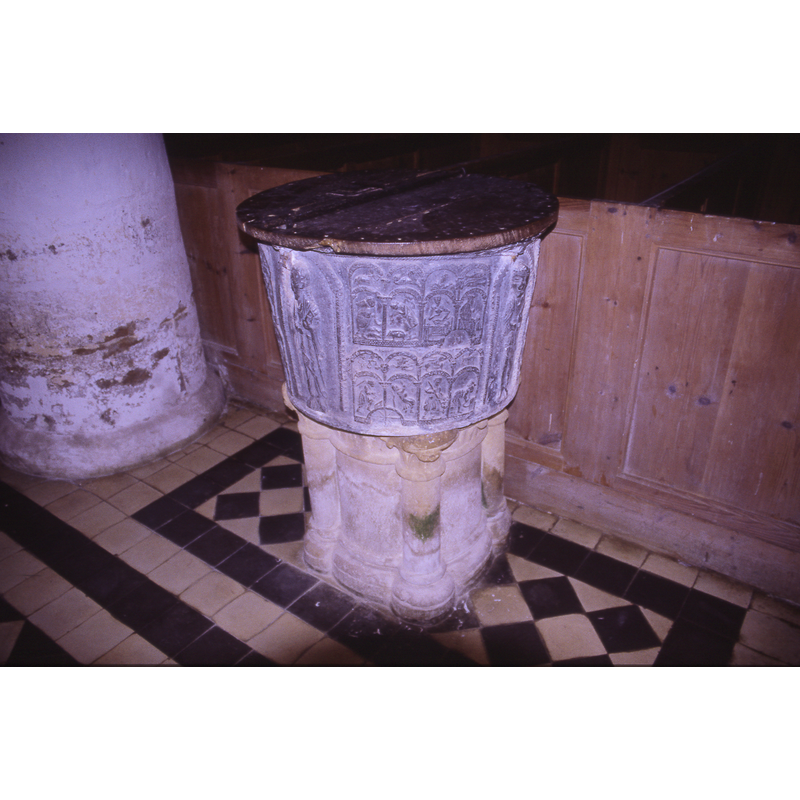Saint-Evroult-de-Montfort / Montfort / Saint-Évroult-de-Montfort / Sainz Evrou
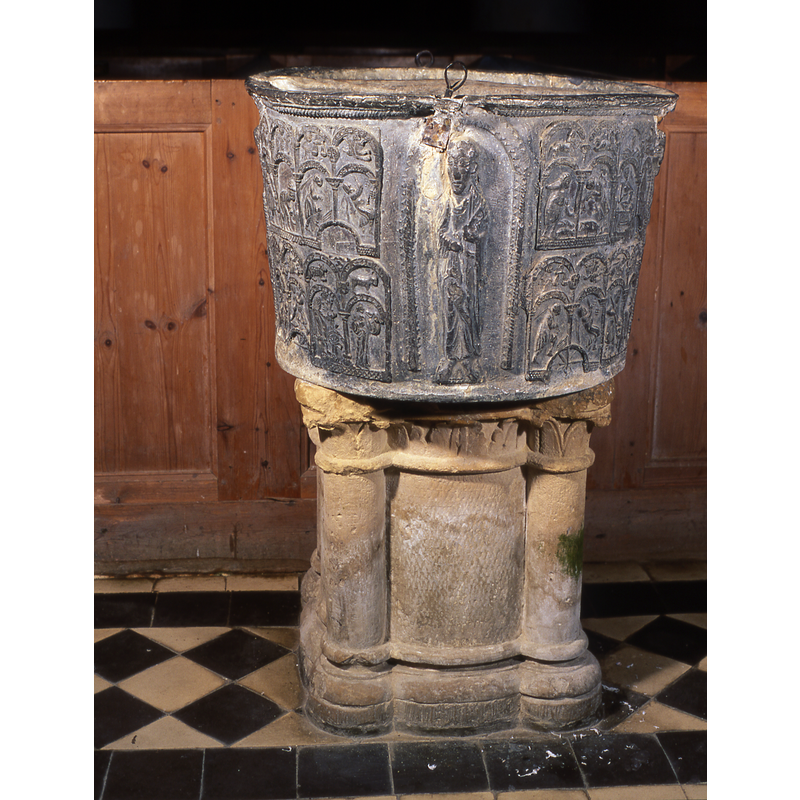
Image copyright © Baptisteria Sacra Index, 2023
Results: 16 records
B1R01: symbol - zodiacal signs
B1R02: nature - labours of the months
B1R03: symbol - zodiacal signs
B2R01: symbol - zodiacal signs
B2R02: nature - labours of the months
view of basin - detail
view of basin - detail
view of basin's top
view of font
view of font and cover in context
INFORMATION
FontID: 00216EVR
Object Type: Baptismal Font1
Church/Chapel: Eglise paroissiale de Saint-Evroult-de-Montfort
Church Patron Saints: St. Ebrulf [aka Ebrulfus, Ebrulphus, Evroul, Evroult]
Church Location: 61230 Saint-Évroult-de-Montfort, France
Country Name: France
Location: Orne, Normandie
Directions to Site: Located 36 km S from Lisieux on the D579 road, via Vimoutiers to Gacé. St-Evroult is 2 km N of Gacé on the N138 direction Bernay, 20 km SE of Vimoutiers
Ecclesiastic Region: Diocèse de Lisieux
Historical Region: Région de Gacé / Pays d'Auge
Font Location in Church: Inside the church, in the W end, S side
Date: ca. 1200? [Zarnecki]
Century and Period: 12th century [Pudelko]; basin 12thC and base 13thC [Ruprich-Robert] [composite font], Romanesque
Workshop/Group/Artisan: lead font
Cognate Fonts: Brookland (Kent, England) was made based on the same program pattern
Church Notes: The church is kept locked but the key is available from the restaurant (truck stop) at the cross-roads that leads to the church.
Font Notes:
Click to view
The lead font at St-Evroult-de-Monfort has, like its cognate in Brookland, Kent, the Labours of the Months and the signs of the Zodiac on two different registers of the basin sides [cf. Index entry for Brookland]. Illustrated, drawing by J-F, in Bouet (1852). Ruprich-Robert (1884-1889) dates the stone base to the 13th century and shows a base made of a cylindrical central stem with four constructional columns, the latter with capitals and bases, the former with zig-zag lines all the way through the sides. On the basin sides, there are four Apostles, each separating the group of scenes. [On-site inspection revealed that the inside of the basin had been divided into two wells using a partition welded vertically across the centre of the basin at a later date, probably following on the later custom in north-western France of using double-fonts or having two separate wells for baptism]. Lethaby (1893) mentions a lead font "very similar to our Brookland font with Zodiac and Seasons. In Enlart (1902). In Uard (1928). Clayton (1929) has described the scenes corresponding to the Labours of the Month in the cognate font at Brookland thus: March: a man pruning a vine; April: a figure holding a branch or flower in each hand (referring to the Rogationtide procession); May: a knight hawking; June: a man mowing with a scythe; July: a man apparently raking hay; August: a man reaping with a sickle; September: a man threshing with a flail; October: a man standing in a vat holding a bunch of grapes; November: a swineherd beating down acorns for the pig beneath; December: a man felling an animal with an axe; January: a two-faced Janus sitting at a table with a drinking horn; February: a man warming himself at a fire. Illustrated in Lasteyrie du Saillant (1929). In Pudelko (1932). In Webster (1970 c1938) with date of the 12th or 13th century. Described and illustrated in Zarnecki (1957) who dates it ca. 1200 and informs that, although "this and the Brookland font [...] are the products of one workshop", there are many differences between the two: slightly different blocks used, separation between the blocks, shape of the blocks themselves, etc. In Musset (1975). Described and illustrated by Denis Lavalle in Les siècles romans en Basse-Normandie (1985). In Malle (1994). Described and illustrated in Drake (2003), who points out that, unlike those on the sister font at Brookland, both the Signs of the Zodiac and the names of the months are captioned in Latin in this font; he also notes that the months are not in the proper order. Listed and illustrated in Palissy [ref.: PM61000599]: "La cuve est en forme de tronc de cône renversé. 16 scènes en relief symbolisent les saisons et les mois, avec, au-dessus, les signes du zodiaque. Chacun des quatre panneaux est séparé par un personnage en pied (Evangéliste). [...] plomb : ciselé, estampage, décor en relief [...] 12e siècle".
COORDINATES
UTM: 31U 302550 5409734
MEDIUM AND MEASUREMENTS
Material: metal, lead
Font Shape: cylindrical (mounted)
Basin Interior Shape: round
Basin Exterior Shape: round
Drainage Notes: The hole is somewhat off-centre and the later partition has created therefore a drained half-well while the other half is drain-less
Rim Thickness: 4-4.5 cm*
Diameter (inside rim): 61-63 cm*
Diameter (includes rim): 70.5-71.5 cm* at top; 59-60 cm* at bottom
Basin Depth: 44 cm*
Height of Basin Side: 45 cm*
Basin Total Height: 45 cm* / 46 cm**
Height of Base: 60 cm*
Font Height (less Plinth): 105 cm*
Square Base Dimensions: 50 x 50 cm*
Notes on Measurements: * BSI on-ste / ** Palissy [ref.: PM61000599]
INSCRIPTION
Inscription Language: Latin
Inscription Notes: The months of the year are distributed in groups of four, one group per register, and bear the corresponding Zodiac sign atop.
Inscription Location: On the little arches above the scenes/figures
Inscription Text: [The months of the year and names of the Zodiac signs].
Inscription Source: BSI on-site; Drake (2003: 348, 350)
LID INFORMATION
Date: modern
Material: wood
Notes: A plain, flat wooden lid of later manufacture with a cross-bar for locking the font
REFERENCES
"Les siècles romans en Basse-Normandie", Printemps 1985, 92, Art de Basse-Normandie, 1985
Las trésors des églises de France: Musée des arts décoratifs, Paris 1965, Paris: Caisse nationale des monuments historiques, 1965
Allen, J. Romilly, "Notes on Early Christian Symbolism", N.S., VI, Proceedings of the Society of Antiquaries of Scotland, 1884, pp. 380-464; p. 432, 432fn3
Bouet, G., "[St-Evroult]", XVIII, Bulletin Monumental, 1852, pp. 423ff; p. 423 ff and ill.
Caumont, Arcisse de, Abécédaire ou rudiment d'archéologie; architecture religieuse (5e éd.), Caen: F. Le Blanc-Hardel, 1867
Caumont, Arcisse de, Abécédaire ou rudiment d'archéologie; architecture religieuse (5e éd.), Caen: F. Le Blanc-Hardel, 1867
Chastel, André, Histoire générale des Églises de France, Belgique, Luxembourg, Suisse, France: Robert Laffont, 1966
Davies, J.G., The Architectural Setting of Baptism, London: Barrie and Rockliff, 1962
Desvaux, [abbé], "A tracers la Vallée d'Auge et le pays d'Ouche", XXI, 1902, Bulletin de la Société histrorique et archéologique de l'Orne, 1902, pp. 271; p. 271
Drake, Colin Stuart, "Romanesque Fonts in Kent: the French Connections", CXXIII, 2003, Archaeologia Cantiana, 2003, pp. 333-352; p. 348, 350 and pl. IX
Enlart, Camille, Manuel d'archéologie française depuis les temps mérovingiens jusqu'à la Renaissance, Paris: Alphonse Picard & fils, 1902
Huard, Georges, Art en Normandie, Paris: Beaux-Arts, éditions d'études et documents, 1928
Lasteyrie du Saillant, Robert Charles, conte de, Architecture réligieuse en France à l'époque romane (2e éd., avec une bibliographie critique par Marcel Aubert), Paris: A. Picard, 1929
Lethaby, William Richard, Leadwork, old and ornamental, and for the most part English [...] with illustrations, London; New York: Macmillan & co., 1893
Livett, G.M., "The Leaden Font at Brookland", 27 (1905), Archaeologia Cantiana, 1905, pp. 255-261; p. 257
Malle, Louis, Sources du baptême: découvrir les baptistères et les fonts baptismaux, Paris: Éditions de l'atelier, 1994
Musset, Lucien, Normandie romane, La Pierre-qui-vire, Yonne: Zodiaque, 1974-1975
Ruprich-Robert, V., Architecture normande aux XIe et XIIe siècles en Normandie et en Angleterre, Paris: Libraririe des imprimeries réunies, 1884-1889
Torrens Alzu, Miguel A., "Pilas plúmbeas II: los trabajos de los meses y los signos del zodíaco en las pilas románicas de plomo de Brookland y Saint-Évroult-de-Montfort", 6 (Junio 2008), Románico: revista de arte de Amigos del Románico, 2008, pp. 32-41; p. 33ff
Webster, James Carson, The Labors of the months in antique and medieval art to the end of the twelfth century, New York: AMS Press, 1970 c1938
Zarnecki, George, English Romanesque Lead Sculpture: Lead Fonts of the Twelfth Century, London: A. Tiranti, 1957


